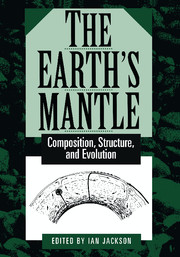Book contents
- Frontmatter
- Contents
- Chapter Outlines
- Contributors
- Dedication
- Preface
- I Accretion and Differentiation of the Earth
- II Dynamics and Evolution of the Earth's Mantle
- 4 Understanding Mantle Dynamics through Mathematical Models and Laboratory Experiments
- 5 Plates, Plumes, Mantle Convection, and Mantle Evolution
- 6 The Mantle's Chemical Structure: Insights from the Melting Products of Mantle Plumes
- 7 Pyrolite: A Ringwood Concept and Its Current Expression
- III Structure and Mechanical Behaviour of the Modern Mantle
- Index
7 - Pyrolite: A Ringwood Concept and Its Current Expression
Published online by Cambridge University Press: 23 November 2009
- Frontmatter
- Contents
- Chapter Outlines
- Contributors
- Dedication
- Preface
- I Accretion and Differentiation of the Earth
- II Dynamics and Evolution of the Earth's Mantle
- 4 Understanding Mantle Dynamics through Mathematical Models and Laboratory Experiments
- 5 Plates, Plumes, Mantle Convection, and Mantle Evolution
- 6 The Mantle's Chemical Structure: Insights from the Melting Products of Mantle Plumes
- 7 Pyrolite: A Ringwood Concept and Its Current Expression
- III Structure and Mechanical Behaviour of the Modern Mantle
- Index
Summary
Introduction
‘Pyrolite’ was chosen by Ringwood (1962a,b) as the name for a model chemical composition for the mantle, consisting predominantly of pyroxene and olivine. Subsequently, the pyrolite concept has been quantified, and assessment of model pyrolite compositions has been a major theme in experimental studies at The Australian National University and the University of Tasmania. Such experimental studies have been designed to achieve an understanding of the mineralogy of the upper mantle, the transition zone, and the lower mantle as a function of pressure and temperature and to investigate the melting behaviour and melt products of the upper mantle to depths of approximately 150 km. The purpose of this chapter is to review the experimental studies of pyrolite compositions relevant to the Earth's upper mantle and to summarize the applications of such studies.
We shall begin with the definition of pyrolite in its historical context before presenting a review of the experimental studies (both published and ongoing) that have been performed on a range of different pyrolite compositions. These experimental studies have emphasized the very important influence of volatile (C + H + O) composition on the solidus position (the pressure–temperature conditions at which melt first appears). The experimental findings have led directly to models for the upper mantle that predict distinctive sub-solidus mineralogies and melting characteristics in particular tectonic environments. In the final part of this chapter we shall consider the petrological constraints on magma genesis based on the pyrolite concept and the findings from the experimental studies.
- Type
- Chapter
- Information
- The Earth's MantleComposition, Structure, and Evolution, pp. 311 - 378Publisher: Cambridge University PressPrint publication year: 1998
- 12
- Cited by

